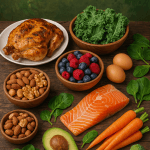In a world full of ultra-processed foods, synthetic ingredients, and lifestyle diseases, many people are turning back to basics—not just in how they live, but in how they eat. Enter the Paleo Diet, also known as the “Caveman Diet” or the “Ancestral Diet.” This eating philosophy is based on one simple principle: if your great-great-great-great-grandmother couldn’t eat it, neither should you.
The Paleo diet emphasizes whole, unprocessed foods that our Paleolithic ancestors thrived on before the advent of agriculture and industrial food production. It’s not a fad; it’s a lifestyle rooted in biology, anthropology, and modern nutrition science. And for many, it’s a path toward healing chronic issues, losing weight naturally, and feeling more energized.
In this comprehensive guide, we explore what the Paleo diet is, why it works, what to eat (and what to avoid), and how you can begin your journey toward a cleaner, more primal way of eating and living.
What Is the Paleo Diet?
The Paleo diet is inspired by the diet of our pre-agricultural hunter-gatherer ancestors. It’s based on the idea that the human body is genetically adapted to eat the way people did during the Paleolithic era, which dates back about 2.5 million to 10,000 years ago.
The modern Paleo approach emphasizes:
Eating whole, nutrient-dense foods Avoiding processed and artificial ingredients Focusing on sustainable, high-quality animal products Supporting the body with natural movement and lifestyle habits
At its core, Paleo is not about deprivation. It’s about nourishment, simplicity, and returning to what our bodies were designed to eat.
The Paleo Philosophy: Why Ancestral Eating Makes Sense
Our ancestors were lean, muscular, and generally free from modern chronic diseases like diabetes, heart disease, and obesity. They didn’t count calories, take supplements, or follow complex meal plans. Instead, they ate nutrient-rich whole foods, moved their bodies regularly, and lived in sync with nature.
The mismatch theory suggests that many modern health problems are the result of a disconnect between our genetic makeup and our modern diet and lifestyle. The body is still wired for a pre-agricultural world, but we’re feeding it refined grains, industrial oils, and sugars that it was never designed to handle.
This evolutionary perspective is what gives the Paleo diet such a solid foundation in natural human biology.
Benefits of the Paleo Diet
Natural Weight Loss
One of the most common and immediate effects of adopting a Paleo lifestyle is sustainable weight loss. Removing refined carbs, added sugars, and processed foods naturally leads to better satiety and lower caloric intake—without needing to count calories.
Reduced Inflammation
Many chronic diseases are linked to inflammation caused by processed foods, refined oils, and sugar. The Paleo diet eliminates these triggers and includes anti-inflammatory foods such as fatty fish, leafy greens, and berries.
Stable Blood Sugar and Insulin Sensitivity
By removing grains and sugars, Paleo helps balance blood sugar levels, reduce insulin spikes, and improve metabolic health. It’s especially beneficial for those with insulin resistance, PCOS, or type 2 diabetes.
Improved Digestion and Gut Health
The Paleo diet eliminates common gut irritants like gluten, dairy (in many cases), and legumes. Many followers report less bloating, better digestion, and fewer GI issues.
Increased Energy and Mental Clarity
By stabilizing blood sugar and eliminating inflammatory foods, Paleo eaters often experience more stable energy, improved mood, and sharper focus throughout the day.
Better Skin, Hair, and Hormonal Health
A diet rich in healthy fats, proteins, and micronutrients supports hormone production, collagen synthesis, and detoxification, leading to noticeable improvements in skin clarity and hair health.
A Stronger Immune System
Nutrient-dense Paleo foods like organ meats, bone broth, and colorful veggies supply the vitamins and minerals your immune system needs to function optimally.
What to Eat on the Paleo Diet
The Paleo diet focuses on foods that could be hunted, fished, or gathered during the Paleolithic era. This means natural, whole, unprocessed foods.
Animal Protein
Pasture-raised meats and wild-caught seafood are central to the Paleo plate.
Beef, bison, lamb, venison
Chicken, turkey, duck
Salmon, sardines, mackerel
Eggs (preferably pastured)
Vegetables
All non-starchy and starchy vegetables are allowed, with a focus on variety.
Spinach, kale, chard
Broccoli, cauliflower, Brussels sprouts
Carrots, beets, sweet potatoes
Zucchini, mushrooms, asparagus
Fruits (in moderation)
Low-sugar, seasonal fruits are best.
Berries (blueberries, raspberries, strawberries)
Apples, oranges, bananas
Melons, kiwi, mango (in moderation)
Healthy Fats
Fats are vital for energy, hormone balance, and satiety.
Avocados
Olive oil
Coconut oil
Ghee
Animal fats (tallow, lard)
Nuts and Seeds
Enjoy in moderation, and opt for raw or dry-roasted versions.
Almonds, cashews, walnuts
Pumpkin seeds, sunflower seeds
Chia and flax seeds (in limited amounts)
Herbs and Spices
Fresh and dried herbs not only enhance flavor but also provide antioxidants.
Garlic, ginger, turmeric
Cinnamon, basil, rosemary
Cumin, oregano, parsley
What to Avoid on Paleo
Grains (wheat, rice, corn, oats)
Legumes (beans, lentils, peanuts, soy)
Dairy (some allow grass-fed butter or ghee)
Refined sugar and sweeteners
Processed foods and snacks
Seed oils (canola, soybean, corn oil)
Artificial additives and preservatives
Alcohol and sugary drinks
Paleo-Friendly Substitutes
Pasta → Zucchini noodles or spaghetti squash
Rice → Cauliflower rice
Flour → Almond or coconut flour
Milk → Almond milk or coconut milk
Sweeteners → Raw honey, maple syrup (sparingly)
Chips → Kale chips, pork rinds, plantain chips (non-fried)
Is Paleo the Same as Keto?
Not exactly. While both diets eliminate processed carbs and emphasize whole foods, there are key differences:
Paleo allows more carbs from fruit and starchy vegetables
Keto requires strict carb limits to maintain ketosis
Paleo isn’t focused on high fat or low carb per se—it’s about quality, not quantity
You can follow a Paleo-Keto hybrid, which combines the ancestral framework of Paleo with the fat-burning focus of Keto.
The Role of Intermittent Fasting
Many Paleo followers naturally integrate intermittent fasting (IF)—not eating for 14–18 hours between meals—to enhance metabolic flexibility, fat burning, and cellular repair. IF pairs well with Paleo as both encourage listening to your body’s hunger cues and avoiding constant snacking.
Sample One-Day Paleo Meal Plan
Breakfast:
Scrambled eggs with sautéed spinach and mushrooms in coconut oil
Half an avocado on the side
Black coffee or herbal tea
Lunch:
Grilled chicken thighs over mixed greens with olive oil, lemon, and avocado
Handful of raw walnuts
Snack:
Boiled egg with cucumber slices
Berry bowl with shredded coconut
Dinner:
Pan-seared wild salmon with roasted Brussels sprouts and sweet potato
Herbal tea with cinnamon
Dessert (optional):
Paleo brownie made with almond flour and raw cacao
Paleo for Athletes and Active Lifestyles
Paleo works exceptionally well for athletes when combined with strategic carb intake from real food sources like sweet potatoes, bananas, and berries. High-protein, high-fat meals promote lean muscle growth, faster recovery, and stable performance.
Post-workout meals might include:
Grilled meat with roasted root veggies
Protein smoothies with banana and coconut milk
Boiled eggs with a baked sweet potato
Common Challenges and How to Overcome Them
Cravings for bread or sugar
Use almond or coconut flour-based recipes to create Paleo-friendly treats during transition weeks.
Social events and eating out
Stick to grilled meats, salads, and veggies. Skip the sauces, bread, and desserts.
Grocery costs
Buy seasonal produce, frozen veggies, and bulk meats. Paleo is affordable when you shop smart.
Feeling tired or “low-carb flu”
Increase water, salt, and magnesium. Add starchy veggies for energy until fully adapted.
Long-Term Sustainability of the Paleo Diet
The goal isn’t to follow rules forever—it’s to reconnect with real food and listen to your body. Once your health improves, some people reintroduce limited non-Paleo foods (like fermented dairy or white rice) while maintaining the Paleo foundation.
That’s what makes it sustainable—it’s flexible, whole-food-based, and intuitive.
Paleo Beyond the Plate: A Lifestyle Approach
Paleo isn’t just about food. It’s a holistic lifestyle that includes:
Movement: Natural, functional exercise like walking, sprinting, lifting, climbing
Sleep: Prioritizing deep, restorative sleep in alignment with circadian rhythms
Sunlight: Daily exposure for vitamin D and mood balance
Connection: Community, purpose, play, and time in nature
Stress reduction: Breathwork, meditation, and mindfulness
This full-body, full-life approach is what makes Paleo a transformational lifestyle, not just a diet.
FAQs
It’s challenging due to the emphasis on animal protein, but some do modified versions with eggs, fish (for pescatarians), and more plants.
Yes, with proper planning. Prioritize nutrient-dense foods like liver, eggs, greens, and healthy fats.
While not a cure, many have reversed autoimmune symptoms, prediabetes, and IBS through Paleo principles.
Most do, especially if coming from a high-carb, processed diet. Paleo encourages fat burning and hormonal balance.
Some feel better in days, while others take 2–4 weeks to adjust. Weight loss and health improvements often begin within the first month.








Post a comment